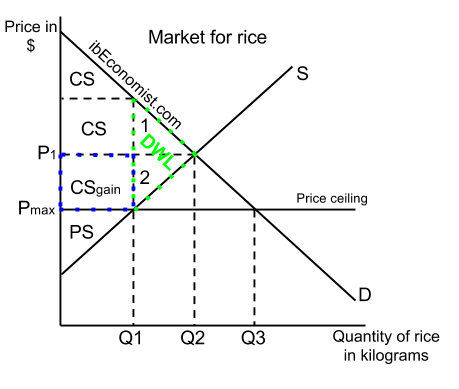Definition:
- Price ceiling (maximum price) – the highest possible price that producers are allowed to charge consumers for the good/service produced/provided set by the government. It must be set below the equilibrium price to have any effect.
Governments will usually impose price ceilings when they believe that the equilibrium price in the market is too high and undesirable (e.g. weak consumers cannot afford a necessity, etc.). Good examples of markets where maximum prices could be imposed are food and housing. Food is a necessity and in developing countries some people might be unable to afford the quantities required for survival. Hence, governments could impose price ceilings on certain foods. Same with the housing market – if equilibrium rent charged is such that a lot of people are homeless, governments might set a maximum price in the housing market (mostly happens in developing countries)

As you can see in the maximum price diagram above – it is set below the equilibrium price (P max < P1). If it is set above or at the equilibrium price – there are no changes.
Assume the market for rice stars in equilibrium where supply is equal demand (S = D) at price P1 and Q2. The government introduces a price ceiling at price P max. At this price, demand is Q3 and supply of rice is Q1. Meaning, there is shortage – excess demand of Q3 – Q1. Price ceiling results in inefficient allocation of resources and DWL triangle appears marked by green dotted line.
Effects of price ceiling on different stakeholders:
- Consumers: lose the upper triangle of DWL marked by 1. Gain a rectangle from producers marked by CSgain (blue dotted line) – this happens due to lower price of the good after government intervention. Whether they are better off depends on the relative price elasticities of demand and supply.
- Producers: lose the lower triangle of DWL marked by 2. Lose the rectangle marked by blue dotted line which goes to consumers due to lower price of the product.
- Government: they do not gain any of the lost welfare. However, you could argue that once food became more attainable society is better off (e.g. nutrition-wise). Having said that, workers could become more productive and other benefits associated with better nutrition arise.
Yet, parallel (underground) markets (shadow economy) could arise. Since there is shortage, people could start buying and selling the good illegally for higher prices than the set maximum price. This might result in government losing tax revenue as well as other problems associated with shadow economy.